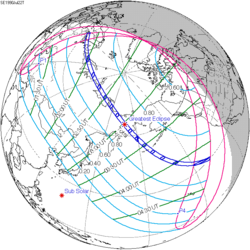| Total eclipse | |
| Gamma | 0.8307 |
|---|---|
| Magnitude | 1.0257 |
| Maximum eclipse | |
| Duration | 105 s (1 min 45 s) |
| Coordinates | 54°30′N79°30′W / 54.5°N 79.5°W |
| Max. width of band | 155 km (96 mi) |
| Times (UTC) | |
| Greatest eclipse | 20:03:41 |
| References | |
| Saros | 124 (50 of 73) |
| Catalog # (SE5000) | 9357 |


A total solar eclipse occurred at the Moon's descending node of orbit between Wednesday, August 31 and Thursday, September 1, 1932, [1] with a magnitude of 1.0257. A solar eclipse occurs when the Moon passes between Earth and the Sun, thereby totally or partly obscuring the image of the Sun for a viewer on Earth. A total solar eclipse occurs when the Moon's apparent diameter is larger than the Sun's, blocking all direct sunlight, turning day into darkness. Totality occurs in a narrow path across Earth's surface, with the partial solar eclipse visible over a surrounding region thousands of kilometres wide. Occurring about 3 days before perigee (on September 3, 1932, at 19:40 UTC), the Moon's apparent diameter was smaller. [2]
Contents
- Observations
- Eclipse details
- Eclipse season
- Related eclipses
- Eclipses in 1932
- Metonic
- Tzolkinex
- Half-Saros
- Tritos
- Solar Saros 124
- Inex
- Triad
- Solar eclipses of 1931–1935
- Saros 124
- Metonic series
- Tritos series
- Inex series
- Notes
- References
Totality was visible from Northwest Territories (today's Northwest Territories and Nunavut) and Quebec in Canada, and northeastern Vermont, New Hampshire, southwestern Maine, the northeastern tip of Massachusetts, and northeastern Cape Cod in the United States. A partial eclipse was visible for parts of the eastern Soviet Union (on September 1 local time), North America, Central America, the Caribbean, and northern South America.








































































































